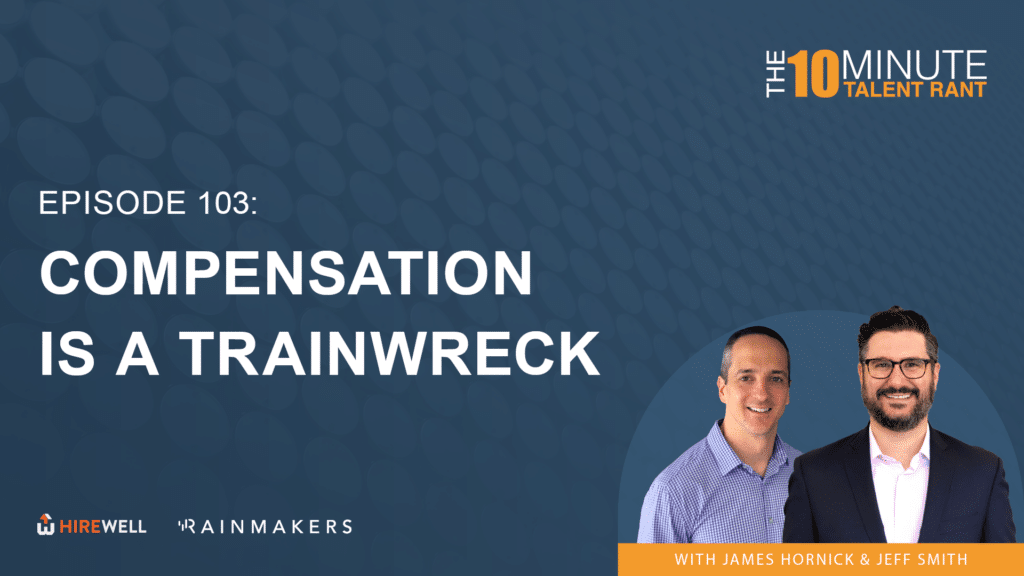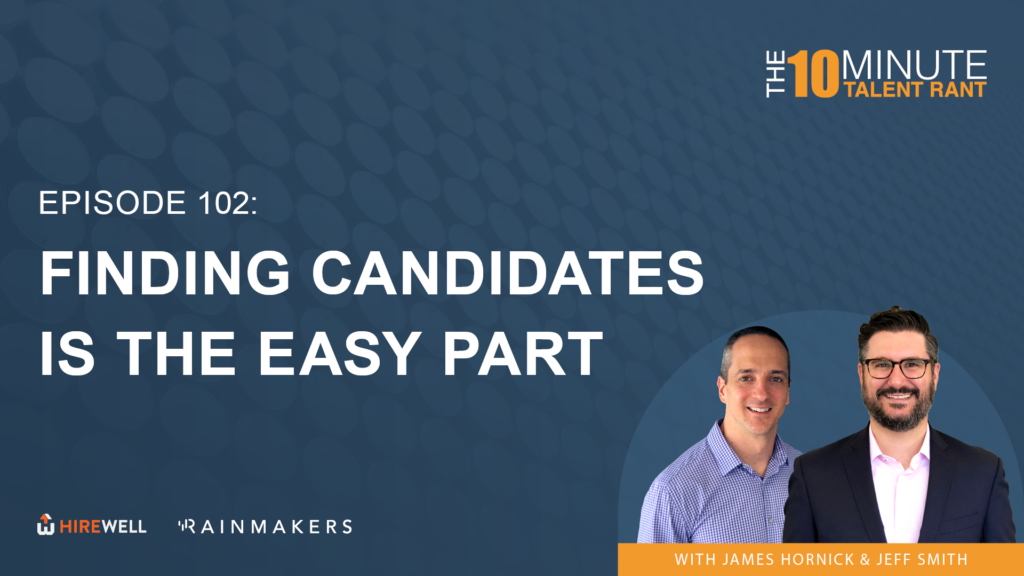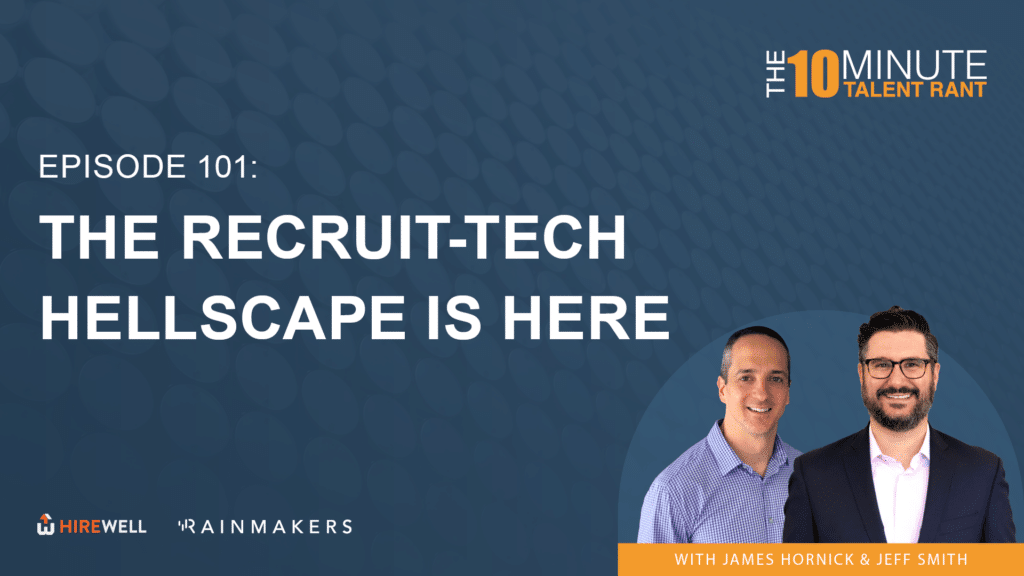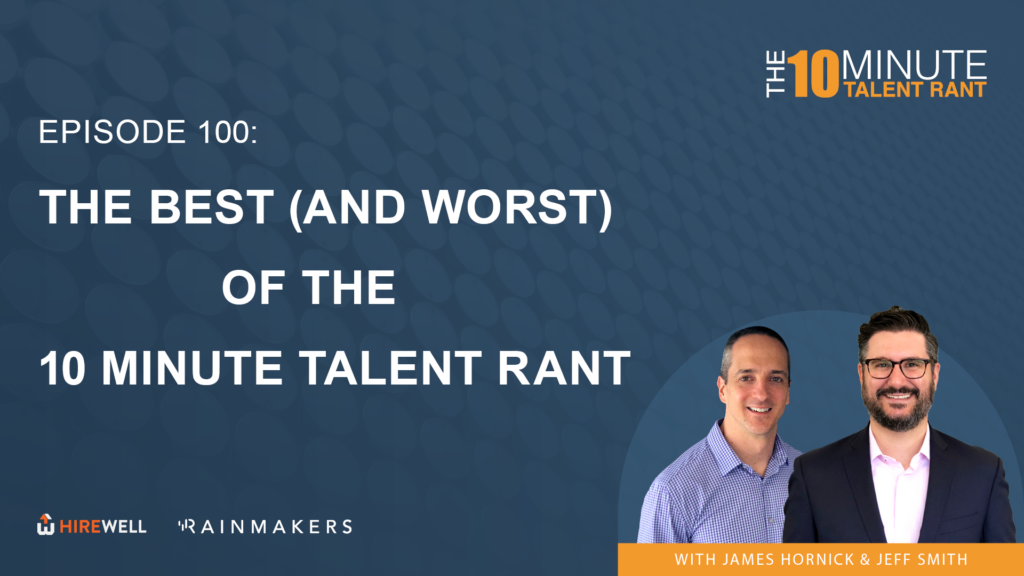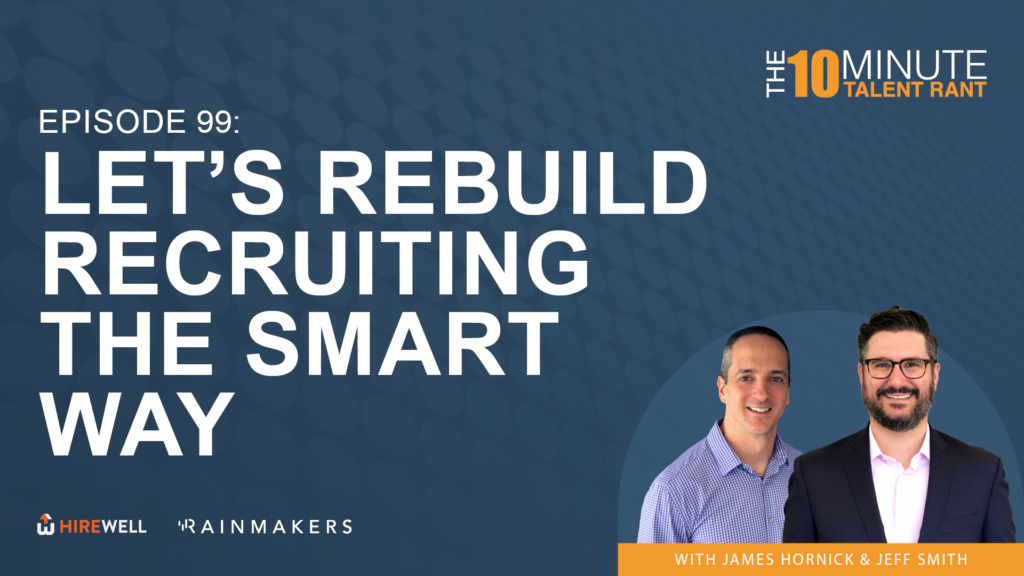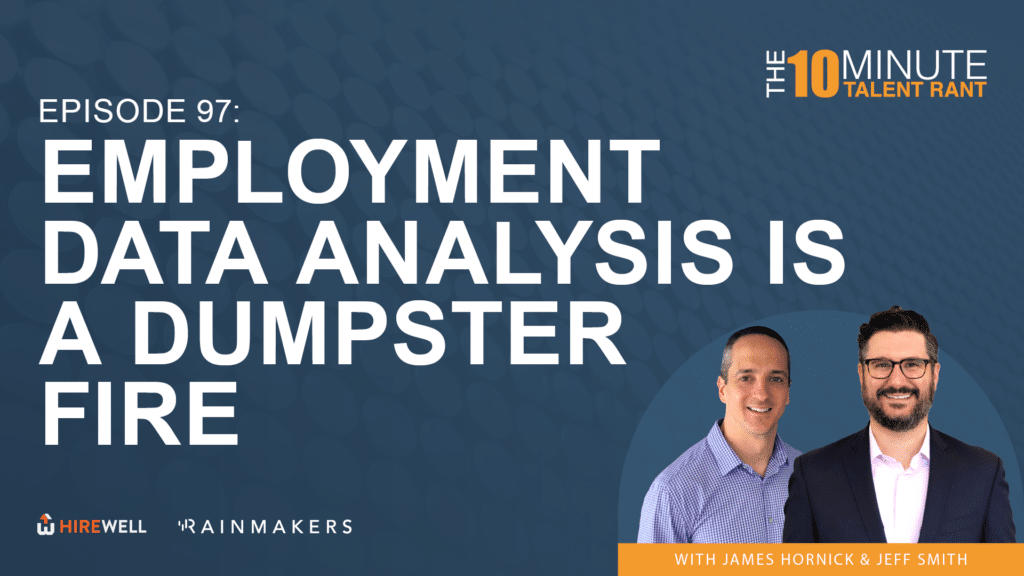The 10 Minute Talent Rant is live. I’m James Hornick joined by Jeff Smith and we are on the clock. The 10 Minute Talent Rant is our ongoing series where we break down things that are broken in the talent acquisition and hiring space, maybe even pitch a solution or two. Before we dig in, all of our content can be found on talentinsights.hirewell.com. This week’s topic, Jeff, are you ready? I am. I have to admit you’re on the, we’re using a different platform today for a few different reasons, but you’re on the wrong side. And so this is- I’m very discombobulated. It’s got y’all messed up. Yeah. We’re trying out Rivers- we’ve been Zoom users for a long time.
Now we’re trying Riverside, which is definitely kind of an updated recording thing. But yeah, I’m hoping this actually even works, so. Yeah, we’ll get used to it. Episode 98, inbound recruiting is broken. Yeah. Yeah. Sure is. So, another trademark “AI chameleoning”. I didn’t make that one up. I think it was Phil, someone from our team that mentioned that one.
I don’t know. I’m claiming it though. He didn’t trademark it. There you go. Absolutely killing job postings as an effective means of hiring. And as I heard today, not all progress, quote fingers, “progress” is good. Yeah, one of our top recruiters came to an upsetting conclusion last week. It truly does take less time to do outbound recruiting, i.
e. headhunting, etc. than it does to post jobs and sit through applications nowadays. Which is nuts when you think about it. It’s crazy. My wife and I had dinner with a couple this weekend in the neighborhood. And, you know, 1 of them asked, they’re out on the market looking around. “Should I be offended that no ones gotten back to any of my applications?”
So I’m biased to this person because we are friends. The truth of the matter is they’re highly successful. As a recruiter, they’re incredibly marketable. And to this point though, they’ve only done kind of that outbound applying and so she said hey, what’s up? And I’m like, well, do you have- do you have a half hour? Meanwhile internally, we’ve got a teammate who one of our top producers on the delivery side- she outright stated that they’re completely over posting jobs and looking at inbound applications. The results are always off target and it becomes a massive time suck. And I should clarify, this is one of our most highly empathetic people, like incredibly altruistic, feels it’s her duty to read every resume and reply thoughtfully.
The whole nine guns. She goes above and beyond. But the massive flood of off target resumes has given her no choice. Either become part of the black hole problem and not give back to people or just do outbound outreach only. And she fills every job she works on by taking that approach. So every recruiter, internal or agency is facing that choice right now and it’s a complete mess.
Yeah. There is no debate inbound recruiting. And that’s where job ads, let the talent come to you has just become way more time consuming than just reaching out to people who’ve never heard of you before, which is absolutely crazy. We talked about this kind of a few shows ago and the culprit here is like, it’s the combination of how easy it is to apply to things.
LinkedIn’s got the easy apply button, but a lot of other sites have something similar too. And all these AI generated applications are just completely breaking already depleted talent acquisition teams. So there’s just a pile up of just unreadable resumes. And if you’re not familiar, there’s a dozen sites out there.
If you Google it, actually say, please don’t- that will literally take your resume and let you apply to a hundred different sites, a hundred different positions, all the click of a button, customizing every resume while it does that. So it makes you look like- hundreds of applications. Yeah. So we talked about AI chameleoning.
That’s what it is. It’s like, you can take your background, but then make yourself look like you’re a better fit for a hundred positions with a click of button than you really are. And you’ve got people doing this at scale. You’ve got thousands, tens thousands, a hundred thousand job seekers doing the same thing.
Talent acquisition teams are already lean. They have been for two years and like all these tools, all these additional noise and volume and everything else. It’s just the candidate experience is in the absolute shitter because no one actually has the time or ability to respond to all these things.
Yeah. And folks might be asking. So what are you all, us recruiters, doing with the applications? And it’s good to take a step back. So there’s 4 different ways we deal with that inbound traffic and unfortunately, only 1 of them is good. Yeah. The teaching moment here. We’re not saying these are good. We’re just saying these are the ways that, like, historically, all the things you’re frustrated about in the job seeking process,
you’re going to hear them all right here. So the first one, because people say this is a fixed port, which I disagree with is using AI on the inbound side. So to do the same keyword matching. So in job seeker terms, this is the reject, the dreaded auto rejection from the ATS. So turning that on. So, while we both think AI in recruiting is kind of voodoo, there’s just increasingly more terrible bots sifting through applications.
It’s not a good thing. We’re actually going to get into this more further. But like, no, I disagree that the auto reject button on the ATS solves anything at all. Yeah, saves time. Yeah. True. Horribly. Number two is recruiters just ignore most of the pile. Eek. But, it’s true. Yeah. In job seekers terms, you’re thinking of, hey, this is the resume “black hole”, up in quotation marks.
Everyone complains about ATSs rejecting them. In reality, resumes just have gotten to the virtual desk, you know, the repository of where these resumes go, and there’s just there’s no one there. There’s no one there to read them. So, on the recruiter side, regrettably, when the recruiter has time to look at the inbound traffic, that’s probably your best shot at getting an interview from an inbound, from you applying to a job.
So, we’ve taken it down to If you applied around the same time that a recruiter decided to look, you literally luck out. The fact that luck is involved in any of this is a complete dumpster fire. The third method, which is kind of what we’re talking about a little bit here, what one of our colleagues is doing, just forego the whole posting process entirely, which in job seeker terms, you’re creating a hidden job market.
There’s jobs out there that aren’t posted anywhere. It seems intuitive that inbound should be the easiest way to get jobs filled, but it’s not. And were seeing firsthand that it’s more efficient and slash you’re not putting anybody out by making them feel like by not getting back to them by just not posting the job and doing entirely outbound.
Not saying it’s a great method, but I’m saying it’s a method. Yeah. Number 4, the obvious good method, aka reading them all. It’s impossible. It’s impossible. There is, I don’t know if there is a fix, but it’s not possible with the way the TA teams are structured now. Good recruiters genuinely want to give folks, everyone a fair chance.
It’s our job. But unfortunately, filling the job quickly with a qualified applicant is their primary responsibility. So the unfortunate part is the inevitable loser in all of this are the hundreds of hundreds of qualified applicants that don’t even get to sniff the job for some of the reasons that we just stated.
Now, let’s be clear about a few things, and I want to go back to the first one we talked about. You could argue that AI technology could still make the first option good. The first option was using AI on the inbound side to do the keywords. The problem is like advanced keyword filtering on that side should hypothetically be able to make sure the best people get looked at.
But the problem is modern AI writing tools are able to customize resumes to individual job descriptions so well, it’s not even a reality anymore. People who absolutely do not fit the role can keyword stuff themselves at scale to make them look like they actually fit the role, which is going to tie up the recruiters time.
Meanwhile, the people, and this is the other thing too, the people who actually do fit those rules get lost in the shuffle. Happens constantly. Because it looks perfect. Yeah. AI chameleoning, it’s put TA teams in a position where they spend hours just looking and talking to the wrong people because they got chameleoned. And this is why we’re kind of talking about this phenomenon.
This wasn’t a thing a year ago we even had to worry about. There’s just no way to fully ensure every application is evaluated fairly without some sort of human conversation, which, again, this isn’t really reality. So no one has the bandwidth TA teams to kind of wiggle the bone. And here we are. Yeah. And so the same thing is happening on the job seeking side too.
Used to take someone 100 applications, 20 conversations, roughly to get 1 job. Now, it’s double that and then some. So if candidates feel forced to apply to exponentially more roles. Yeah. There it is. There it is. That’s the problem. The grossest part is the people who get hurt by this the most are the ones who follow the rules.
The ones who only apply who are really, really thoughtful about the jobs that they’re genuinely interested in, and they truly believe that they are a solid fit for. These are the folks that are getting lost in the shuffle and we’ll mention it at the end. But the real double whammy is it just disproportionately affects minority applicants, which, of course makes all of this ten times worse.
Meanwhile, outbound recruiting, headhunting as we’ve been saying, it provides a big unseen benefit, at least for us. It allows for conversations to happen before the use of any AI can help a candidate repackage themselves. So no one gets the answers to the test before the recruiter can ask the question.
So it just becomes a much more genuine conversation and vetting process. Yeah, and that’s kind of the thing I think that needs to be just understated here again. It’s like you’re- when you take away people’s ability to teach the test, like you have a more genuine conversation, as a recruiter. Unfortunately, it comes down to whatever, like everyone who’s doing any search is going to have some sort of bias gets baked into how they decide to look at people.
So there’s that. Counterpoint on outbound though, because I do want to talk about this for a second, because this is also pretty funny. AI is starting to affect that too. Like when we were talking about this, we had several people on our team that were actually questioning their own sanity recently because they’re all like, do I still know how to do a Boolean search?
Am I doing something wrong? Because they- multiple people, multiple senior people here who know what they’re doing, been doing this a long time, they kept running searches and having a few people that, that popped up, not fit the job at all and not even have what they searched on. And they’re like, what the hell is going on?
Like, why do I keep seeing- they sent screenshots of it. It was, I was like, oh my gosh, this is like really happening. And so there’s two things basically happening. So the first one, like sometimes the AI hallucinates. So what LinkedIn recruiter does, if you’re a job seeker and you have your profile, you can attach a resume to your profile.
Now, you’ll never see this within your profile, but with a LinkedIn recruiter, the upgraded package that recruiters actually pay for, it’ll actually augment and add to your profile based on your resume. And make that all searchable. So there are specific cases where we actually were able to see that literally made up jobs people did not have, because it misinterpreted their resume when it kind of put that stuff into their actual profile that we’re searching on.
Yeah. The AI I took mushrooms. It’s happening. I don’t know. Another one was, there’s this trick. It’s white text keywording. Some people know about it, but if you don’t, you can take white text, put the keywords into your document, which humans can’t see, but a keyword scraper can. And so those details were getting thrown into LinkedIn searches with the help of LinkedIn’s AI enhancers. And you know, you’d have a resume that looked, you know, pretty well done and then you’d turn on like the white enhancement and it was thousands of words.
Yeah. We’re just trying to grab the AI bot or whatever. So that’s not helpful. And like I said before, we’re not going to dive into the DEI aspects because truthfully, neither of us have any real data. But we start talking about, you know, things like resourceful and savvy and like- we should all be able to agree that it probably leads to minorities getting excluded at higher rates, which I think ultimately is the largest problem of all of it.
It’s also a gender thing too. Like there’s been plenty of studies out there. Like men are more likely to just apply to any damn thing they want to whereas like women are typically, again, this is just statistically across populations, but this just intensifies it. We have some takeaways. Long story short is AI customization of resumes and easy apply buttons take off.
Like it’s just, it’s getting more and more impossible to actually look inbound, which is causing a problem. And it’s getting more efficient just to head hunt. If you’re trying to get stuff filled quickly and on time, which is actually what our job is. Yep. And if you’re a job seeker, it’s never, ever been more important to network.
Get yourself out there. If the trend continues that this hidden job market is, it has legs. It’s just going to keep getting bigger and bigger. And the folks that unfortunately apply to just applying to jobs are going to be left out. Yeah.
We are short on clock. That’s a wrap for this week. Thanks again for tuning in the 10 Minute Talent Rant, part of the Talent Insights series which is always available for replay on talentinsights.hirewell.com as well as YouTube, Apple podcasts, Google podcasts, Spotify, and Amazon. Jeff, thanks again as always. Everyone out there, we will see you soon.







